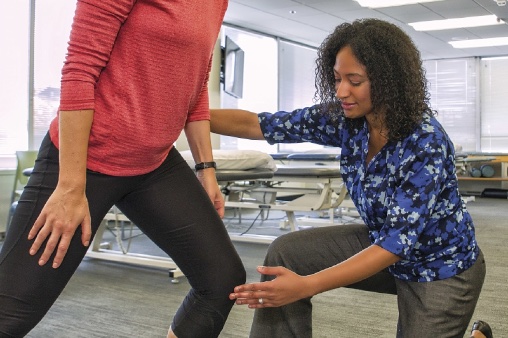 The American Physical Therapy Association (APTA) is launching a public education campaign, #ChoosePT, to raise awareness among patients and prescribers about physical therapy as a safe alternative to opioid drugs for pain management. The campaign also hope to remind patients of their tight to decide method of pain treatment.
The American Physical Therapy Association (APTA) is launching a public education campaign, #ChoosePT, to raise awareness among patients and prescribers about physical therapy as a safe alternative to opioid drugs for pain management. The campaign also hope to remind patients of their tight to decide method of pain treatment.
Prescription opioid medicines like codeine, oxycodone, hydrocodone, methodone, and others mask the sensation of pain by interrupting pain signals to the brain, but do nothing to treat conditions that cause pain.
Consequently, while opioids have a legitimate and important place as effective treatments for moderate to severe short-term pain such as pain associated with acute injury, and in cancer treatment, palliative care, and end-of-life care, they have serious shortcomings when used to address long-term or chronic pain, such as that experienced by people with fibromyalgia. Opioid side-effects well-known and documented, may include depression, addiction, and constipation, as well as major withdrawal symptoms when a patient who has become habituated stops taking the drug.
Death from overdose is a legitimate, well documented danger.
More than 165,000 people in the United States have died from opioid pain medication-related overdoses since 1999, and each day more than 1,000 people are treated in hospital emergency rooms for misusing prescription opioids, according to the Centers for Disease Control and Prevention (CDC).
The CDC reports that prescriptions for opioids have nearly quadrupled since 1999, with an estimated 20 percent of patients who go to doctor’s offices seeking pain medication without having cancer-related pain symptoms or other pain-related illness or injuries.
A 2012 study revealed that health care providers that year wrote 259 million opioid pain medication prescriptions – enough for every adult in the United States to have their own bottle. Opioid prescriptions per capita increased 7.3 percent from 2007 to 2012, particularly in family practice, general practice, and internal medicine compared with other medical specialties.
Recognizing that the degree of opioid overuse in the U. S. has had reached a level of concern that designated it as a public health problem, the CDC in March released a new set of guidelines urging prescribers to rely less on opioids and opt for non-drug alternatives for treating pain whenever possible.
Chronic pain tends to be variably defined, but within the CDC guideline, it is pain that typically lasts more than three months or past the time it takes for normal tissue healing. Chronic pain can result from underlying medical diseases or conditions, injury, medical treatment, inflammation, or an unknown cause. From 1999-2001, according to the National Health and Nutrition Examination Survey, 14.6% of adults experience current widespread or localized pain lasting at least three months. Data from the 2012 National Health Interview Study showed 11.2% of adults (25.3 million) report living with daily pain.
CDC guidelines maintain that clinicians should consider a full range of therapeutic options for treating chronic pain. One such recommended alternative is physical therapy. Physical therapists treat pain through movement and patients get to play an active role in their recovery.
Photo courtesy of the American Physical Therapy Association
Physical therapists can also play a role in patient education, including setting realistic expectations for recovery, with or without opioid medication.
APTA suggests that even in cases where evidence supporting long-term benefits of non-opioid therapies is limited, risks are much lower with non-opioid treatment plans. All experts agree that opiods should be avoided as first line pain medication, but when the drug is prescribed, so should physical therapy.
Physical therapists treat patients of all ages and physical abilities, and in cases of chronic pain or function problems related to low-back pain, hip or knee osteoarthritis or fibromyalgia — conditions that affect millions of Americans.
 “Opioids come with numerous serious side effects and only mask the sensation of pain,” observes a physical therapist, clinical researcher and #ChoosePT campaign spokesperson Joseph Brence who treats a wide range of pain related conditions, including complex regional pain syndrome, fibromyalgia, and chronic fatigue syndrome. “Research shows that physical therapist treatment can reduce or eliminate the need for opioids by improving physical function, increasing range of motion, and decreasing pain.”
“Opioids come with numerous serious side effects and only mask the sensation of pain,” observes a physical therapist, clinical researcher and #ChoosePT campaign spokesperson Joseph Brence who treats a wide range of pain related conditions, including complex regional pain syndrome, fibromyalgia, and chronic fatigue syndrome. “Research shows that physical therapist treatment can reduce or eliminate the need for opioids by improving physical function, increasing range of motion, and decreasing pain.”
The national #ChoosePTcampaign will focus special attention on key states identified by the CDC as having the highest numbers of drug overdose deaths.
According to 2014 reports, West Virginia, New Mexico, New Hampshire, Kentucky, Ohio, and Rhode Island reported the most deaths from overdose. In a 2012 report, the highest number of opioid prescriptions were found in Tennessee, Alabama, West Virginia, Oklahoma, Kentucky, and Mississippi.
APTA also is working with lawmakers in Washington, DC in its efforts to address the opioid crisis.
People interested in supporting the campaign on social media or learn more can use the #ChoosePT hashtag and follow @MoveForwardPT on Facebook, Twitter, and Pinterest.



